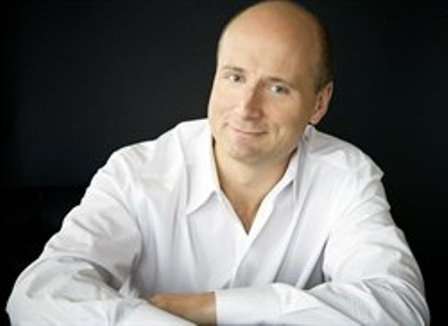|
Back
Auspicious Debut for Estonia’s Järvi Festival Pärnu
Pärnu Concert Hall
07/28/2011 -
Tõnu Korvits: Sung into the Wind
Robert Schumann: Symphony No. 1 in B-flat Major, Opus 38
Jean Sibelius: Violin Concerto in D Minor, Opus 47
Anna-Liisa Bezrodny (violin)
Järvi Festival Orchestra, Paavo Järvi (conductor)

P. Järvi (Courtesy of JSF)
Newest arrival on the festival scene, the International Järvi Summer Festival, blew into Pärnu, Estonia July 28. Named for the Järvi family of Estonian musicians, the mixed symphonic and chamber music event features an impressive array of artists (more than 40) including ten with the patronymic Järvi.
It arrived, appropriately enough, with Estonian composer Tõnu Korvits’ Sung into the Wind, a 2006 tone poem that culls the breezes to ravishing effect. With festival artistic adviser Paavo Järvi conducting the Järvi Festival Orchestra, the jewel-like Pärnu Concert Hall – situated on the banks of the Pärnu River as it flows into the Baltic Sea – also rang with Finnish neighbor Sibelius’ Violin Concerto in an exquisite performance by Anna-Liisa Bezrodny and Robert Schumann’s Symphony No. 1 (“Spring”).
Stars of the show, along with Bezrodny and Järvi, were the members of the Järvi Festival Orchestra, an all-star band comprising mostly Estonian musicians, some from the Estonian National Orchestra, some returning from studies abroad, plus guests and friends such as concertmaster Florian Donderer, concertmaster of the Deutsche Kammerphilharmonie Bremen (which Paavo Järvi heads) and Swiss clarinetist Fabio di Casola. Playing principal flute was Maarika Järvi (Paavo’s sister), with cousin Marius Järvi joining the cello section. Energized by their conductor, the ensemble made a distinguished debut, playing with passion, commitment and the kind of “something extra” that youth and inspiration own.
Kõrvits’ inspiration for Sung into the Wind came from Estonia’s natural environment and native folk songs. The neo-impressionistic work is drenched with color, from the subtlest hint of percussion to full brass. Through-composed, it has six images built into it: “Wind Harp,“ “A Gust of Winds,“ “Wind Fairy,“ “Wind Harp II,“ “Sung into the Wind“ and “The Winds Have Arrived.“ Opening with woodwind and percussion, there were rustling trills and string arpeggios before a touch of cymbal brought a gust, gentle at first, then growing heavier. There were “fairy“ sounds, like glockenspiel, flute, harp and string harmonics, and a spot where Tõrvits conjures Debussy’s La Mer and its winds. The brasses blew through their mouthpieces at the end followed by soft wood chimes. Tõrvits took a well-deserved bow.
Bezrodny, 29, showed herself a consummate musician in the Sibelius. Rarely has the reviewer heard this concerto performed with such beauty of tone and artistic sensitivity, from the hushed beginning to the electrifying finale. Her controlled, expressive vibrato, sometimes stopped for effect, played a large part in this, as did her focused bowing. Whether gauzy, silvery, gutsy or downright refulgent, her sound was breathtaking. Here is a violinist who knows how to traverse the lowest string of the violin, as she did in the opening statement of the second movement, with never a harsh or throaty sound but fine spun, like silk, even in the highest register. There was total silence in the hall after she brushed a feathery harmonic, anticipating the bustling finale. Järvi attended fully both to the symphonic and accompanimental aspects of the concerto, crafting juicy orchestral tuttis in the first and final movements and a lovely, contemplative introduction to the second.
Järvi led the Schumann from memory (he is in the midst of a Schumann cycle with the Deutsche Kammerphilharmonie Bremen). There was uncommon energy and unalloyed joy in his conducting, a kind of optimism that bodes well for the fledgling festival. It was a “Spring” rife with enthusiasm, rich and red-blooded, with a lovely stream of sound in the Larghetto. He attended to every detail, with finely woven textures and balances, hauling the musicians to their feet, individually and as a whole, to bask in the ovation at the end. Response was such that Järvi led them in a repeat of the finale as an encore, which brought the audience to its feet, as well.
The Järvi Festival continues through August 4 in Pärnu, with an “encore“ at Leigo Lakes in South Estonia Aug. 6 (Beethoven and Johann Strauss, Jr.) where Neeme Järvi will conduct the Estonian National Youth Symphony Orchestra on a barge on the lake, complete with onshore fire and color effects.
Järvi Summer Festival
Mary Ellyn Hutton
|